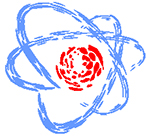Speaker
Description
Summary
Key words: Nuclear measurement system, transmission technique, backscatter technique, buildup factor, MCNP, Compton scattering, measurement errors, RSQ function
[1] J. S. Charlton, J. A. Heslop and P. Johnson, “Industrial applications of radioisotopes”, Phys. Technol., vol. 6, no. 2, pp. 67, 1975.
[2] IAEA-TECDOC-1459, ISBN 92-0-107805-6, 2005.
[3] M. Khorsandi and S. A. H. Feghhi, “Design and construction of a prototype gamma-ray densitometer for petroleum products monitoring applications”, Measurement, vol. 44, no. 9, pp. 1512-1515, November 2011.
[4] R. B. J. Palmer and J. Phys. E: Sci. Instrum., vol. 15, no. 9, pp. 873, 1982.
[5] C. E. Moss, A. Favalli, J. M. God, K. D. Ianakiev, M. Lombardi, C. W. McCluskey, M.T. Paffett and M. T. Swinhoe, “New technology for transmission measurements in process pipes”, Appl. Radiat. Isotopes, vol. 72, pp. 89-95, February 2013.
[6] G. Knoll, Radiation Detection and Measurement, Third edition, New York: John Wiley & Sons, Inc., 2000.
[7] D. Sardari, A. Abbaspour, S. Baradaran and F. Babapour Mofrad, “Estimation of gamma- and x-ray photons; buildup factor in soft tissue with Monte Carlo method”, Appl. Radiat. Isotopes, vol. 67, no. 7, pp. 1438-1440, August 2009.
[8] H. Cember and E. Johnson, Introduction to Health Physics, Fourth edition, USA: McGraw-Hill Companies, Inc., 2009.
[9] S. M. Golgoun, D. Sardari, M. Sadeghi and F. Babapour Mofrad, Appl. Radiat. Isotopes, vol. 118, pp. 246-250, December 2016.
[10] N. Tsoulfanidis and S. Landsberger, Measurement and Detection of Radiation, Third edition, CRC press Taylor and Francis Group, L.I.C, 2010.
[11] R. P. Gardner, W. L. Dunn and F. H. McDougall, “A quality factor concept for evaluation of the surface type gamma-ray backscatter soil density gauges”, Nucl. Eng. and Des., vol. 16, no. 4, pp. 399-407, January 1971.
[12] J. Briesmeister, MCNP-A General Monte Carlo N-Particle Transport Code, 2000.
[13] E. R. Van der Graaf, J. Limburg, R. L. Koomans and M. Tijs, “Monte Carlo based calibration of scintillation detectors for laboratory and in situ gamma ray measurements”, J. Environ. Radioact., vol. 102, pp. 270-282, January 2011.

